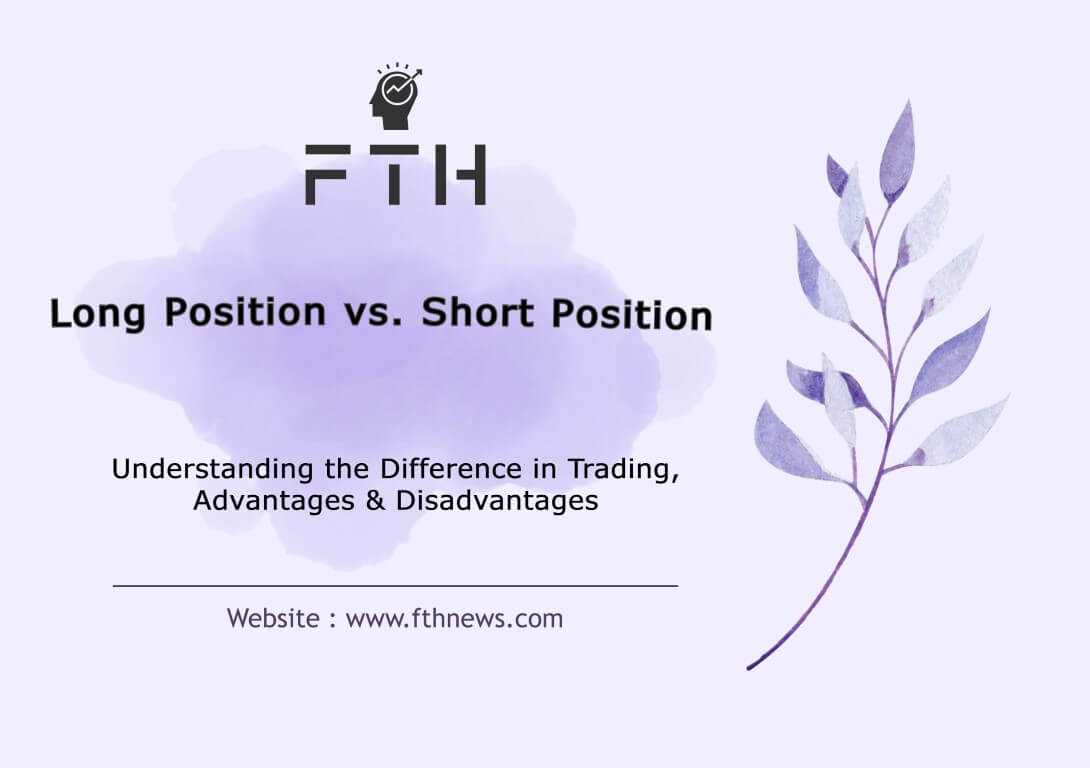
Long Position vs. Short Position: Understanding the Difference in Trading
Long Position vs. Short Position When it comes to successful investing, analysts and market makers frequently refer to investors who adopt either Long Position vs. Short Position.
positions are strategies employed for strategic buying and selling to minimize losses. In this article, we will delve into each of these scenarios, exploring their distinctions and similarities.
Understanding Long Positions in Investment
A long position refers to an investment strategy where investors anticipate the price of a particular asset, such as stocks, mutual funds, currencies, or derivatives like options and futures, to increase in value over time. In a long position, the investor holds the asset with the expectation that it will appreciate in the future, allowing them to profit from this anticipated upward movement in price.
For example, if an investor believes that the price of a specific stock is going to rise, they may choose to establish a long position by purchasing that stock at its current price. By doing so, they aim to benefit from potential future price increases. On the contrary, if an investor anticipates that an asset’s price will decrease, they would typically plan to sell it at a higher price, thus avoiding a long position in that asset.
Types of Long Positions in Investment
The term “long” in investment can take on various meanings depending on the context. While the most common understanding of a long position refers to the duration of holding an investment, it also holds different connotations when used in the context of options and futures contracts. In this section, we will explore the different types of long positions and their implications in the world of finance.
Long-Term Investment: Holding an Investment
Long-term investment in stocks or bonds represents the traditional approach to participating in the capital markets, particularly for retail investors. In this section, we’ll explore the concept of long-term investing, where investors acquire assets with the intention of holding them for an extended period. The primary objective is to capitalize on the anticipated growth in asset value over time, typically without immediate plans to sell.
Long-term investing often involves adopting a “buy and hold” strategy. With this approach, an investor purchases an asset and retains it in the market for an extended duration, confident that its value will appreciate in the future. Unlike active traders who constantly monitor and time the market, long-term investors are inclined to weather the market’s natural fluctuations.
It’s important to recognize that the buy and hold strategy eliminates the need for constant market timing and allows investors to endure the inevitable market ups and downs. Furthermore, over extended periods, time tends to favor investors, as the market generally exhibits an upward trajectory. However, it’s crucial to acknowledge that long-term investments may also face challenges, particularly during extended bear markets, which can favor short sellers and those betting on asset declines.
While long-term investment offers numerous advantages, such as the potential for significant capital appreciation, it’s essential to consider the trade-offs. Long-term investors may miss out on other opportunities that require more active management and quick decision-making. Therefore, finding the right balance between long-term holdings and other investment strategies is a key consideration for investors seeking to achieve their financial goals.
Long Position in Options Contracts
When it comes to option trading contracts, a long position is a strategic stance in which an investor aims to profit from an anticipated increase in price. Long positions can be established in both bullish and bearish markets. In this section, we’ll delve into the concept of a long position in options trading, exploring how it relates to market trends and investor expectations.
Bullish Long Position
Belief in Asset Appreciation: An investor adopting a long position with options contracts is expressing confidence that the underlying asset’s value will rise over the long term. This optimism leads them to use options to secure the right to buy the asset at a predetermined price until the option’s expiration date.
Capital Preservation: Investors who choose to hold their capital while employing options are essentially safeguarding their resources while betting on the asset’s long-term growth.
Bearish Long Position
However, not all traders with long positions expect asset values to increase. For instance, an investor who holds a long put option anticipates a decrease in the asset’s price. In this case, a long position in options trading, whether it’s a call option or a put option, can indicate the investor’s outlook on the market, whether it’s bearish or bullish.
In summary, a long position in options contracts reflects an investor’s belief in the future price movement of an underlying asset. Whether it’s a call option expressing optimism about price increases or a put option signaling a bearish outlook, these positions play a critical role in options trading strategies.
Long Futures Contracts: Hedging Against Price Changes
Investors often turn to long futures contracts as a means of safeguarding themselves against unfavorable price fluctuations. These contracts differ from options in that the holder is obligated to either buy or sell the underlying asset. To illustrate this concept further, consider the following example:
Practical Application
Let’s say a construction company has a strong belief that the price of steel will experience a short-term increase. To protect against potential price hikes, the company decides to enter into a long futures contract with its steel supplier. In this contract, the manufacturer commits to purchasing a specified amount of steel from the supplier in three months’ time, and they agree on a fixed price of $1,200 per ton.
Here’s the key point: Regardless of whether the market price of steel after three months is above or below $1,200 per ton, the company, with a long position in steel futures, is obligated to buy the steel from the supplier at the pre-agreed contract price of $1,200 per ton. Simultaneously, the supplier is likewise bound by the contract’s terms to deliver the physical steel to the construction company once the contract expires.
In essence, a long futures contract serves as a protective mechanism, ensuring that the construction company can secure a set price for their steel supply, shielding them from the potential downside of price fluctuations. This financial instrument plays a critical role in managing risk and price volatility in various industries and markets.
Advantages of Long Position:
Profit from Asset Appreciation: Long positions offer the opportunity to profit when the value of the underlying asset increases. As the asset’s price rises, the value of your investment also goes up.
Diversification: Long positions can be used to diversify a portfolio by including a variety of assets, such as stocks, bonds, or real estate, to spread risk and potentially achieve more stable returns.
Flexibility: Long positions can be used not only for buying assets but also for selling them. For instance, you can profit from selling an asset that you previously bought at a lower price if its value has appreciated.
Use in Options: Long positions are also used in options trading. For example, you can have long call options, which allow you to profit from an increase in the price of the underlying asset, or long put options, which enable you to profit from a decrease in the asset’s price.
Disadvantages of Long Position:
Losses in Price Declines: The primary disadvantage of long positions is that you can incur losses when the value of the asset decreases. This can result in a reduction of your investment’s worth.
Risk with Call Options: When holding long call options, if the stock price does not rise as anticipated, you may experience losses due to the premium paid for the options.
Limited Profit Potential: While long positions offer the opportunity for profit, they also come with a limit on how much you can earn. Your profit potential is tied to the asset’s increase.
Risks of Inverse ETFs: Long positions in inverse exchange-traded funds (ETFs) can be risky, especially when held for extended periods. These ETFs aim to profit from declining markets, but they may not perform as expected over time due to factors like compounding and expenses.
It’s crucial for investors to carefully consider the advantages and disadvantages of long positions, along with their investment goals and risk tolerance, when building their portfolios or engaging in trading activities.
Understanding Short Position: A Strategic Bet on Price Decline
Long Position vs. Short Position , A short position is a trading strategy where a trader engages in the purchase and sale of an asset with a unique twist. This strategy is typically employed when there is a strong conviction that the asset’s price will undergo a significant decline shortly. When establishing a short position, traders essentially borrow the asset at the current price, intending to return it later by buying it back at a lower price.
In this tactical maneuver, there exists a capped potential for profit, but what truly sets it apart is the lurking potential for limitless losses. The trader is essentially betting on the asset’s value sinking, and the extent of their losses hinges on how far and fast the price might unexpectedly surge upward.
Advantages of Short Position:
Profit in a Bearish Market: One of the primary advantages of a short position is the ability to generate profits in a bearish or declining market. While traditional long positions depend on asset value increases, short sellers can capitalize on falling prices.
Portfolio Diversification: Short selling allows investors to diversify their portfolios by incorporating both long and short positions. This diversification strategy can help mitigate overall portfolio risk and enhance returns.
Disadvantages of Short Position:
Interest Costs: Short sellers are obligated to pay interest on the borrowed assets. This interest expense can accumulate over time and diminish potential profits.
Unlimited Risk: Short selling carries the inherent risk of unlimited losses. Unlike long positions, which can only lose the initial investment amount if the asset becomes worthless, short sellers can face boundless losses if the asset’s price rises substantially.
Timing Challenges: Timing is critical when short selling. Accurately predicting when an asset’s price will decline can be challenging, and mistimed positions can lead to significant losses.
Margin Calls: If the asset’s price rises significantly, short sellers may receive margin calls from their brokers. These calls necessitate additional deposits to cover potential losses, which can result in forced liquidation of the short position at unfavorable prices.
Vulnerability to Rapid Price Spikes: Short sellers are susceptible to sudden price spikes caused by unexpected news or events. These rapid increases in price can lead to substantial losses if short positions are not closed promptly.
It’s essential for traders and investors to carefully weigh the advantages and disadvantages of short positions, along with their risk tolerance and trading strategy, before engaging in short selling activities.
Comparison of Long Position vs. Short Position:
To gain a deeper understanding of these two investment strategies, it’s essential to explore their distinctions and commonalities.
Similarities Between Long Position vs. Short Position:
Market Outlook Requirement: Both long and short positions require a market outlook or a price prediction for a specific asset. Investors must form an expectation about whether the asset’s price will rise (bullish) or fall (bearish).
Option Strategies: Long and short positions can be applied in option trading. In a bullish market scenario, investors may opt for a long position in call options, while in a bearish market, they may consider a short position in call options.
By examining their similarities, we can see that both long and short positions rely on an investor’s anticipation of market movements and can be implemented using option contracts to align with those expectations. However, their fundamental difference lies in how they profit from these expectations: long positions benefit from rising prices, while short positions profit from falling prices.
Differences Between Long Position vs. Short Position:
To gain a comprehensive understanding of these two investment strategies, it’s crucial to explore their differences:
Market Outlook:
Long positions are employed when investors anticipate a bullish market, expecting the price of an asset to rise.
Short positions are used in bearish markets, where investors predict a decline in the asset’s price.
Profit Direction:
Long positions profit from increasing asset prices; investors make money when the asset’s value goes up.
Short positions, on the other hand, profit from decreasing asset prices; investors make money when the asset’s value goes down.
Risk Profile:
Long positions have a limited risk profile. Investors can lose only the amount they initially invested if the asset’s price drops to zero.
Short positions carry the risk of unlimited losses. If the asset’s price rises significantly, short sellers can incur substantial losses.
Interest Costs:
In short positions, investors typically pay interest or borrowing costs to the broker because they are effectively borrowing the asset to sell it. This interest expense can accrue over time.
Long positions do not involve interest payments to brokers, as investors purchase and own the asset outright.
In summary, long and short positions represent opposing strategies based on market expectations, profit direction, risk exposure, and the potential for interest costs. Understanding these distinctions is essential for investors to make informed decisions and manage their portfolios effectively.
Examples of Long and Short Positions:
Let’s illustrate the concepts of long and short positions with practical examples:
Long Position Example: Imagine an investor named Sarah who believes that the stock of Company X is undervalued and will increase in value over time. She decides to purchase 100 shares of Company XYZ at $50 per share, investing a total of $5,000. Sarah holds a long position in Company XYZ because she owns the shares. Over the next year, the stock price indeed rises to $70 per share. Sarah decides to sell her shares, realizing a profit of $20 per share ($70 – $50) or $2,000 in total ($20 x 100 shares). Her long position allowed her to benefit from the stock’s price appreciation.
Short Position Example: Consider a commodities trader named John who owns a warehouse full of aluminum. He’s concerned that the price of aluminum may decline due to market conditions. To hedge against this potential loss, John decides to take a short position in aluminum futures contracts. He sells aluminum futures contracts at the current market price of $2,000 per ton. Later, the price of aluminum falls to $1,800 per ton. John buys back the contracts at the lower price to close his position. The difference between the selling price and the buying price, $200 per ton ($2,000 – $1,800), represents his profit on the short position.
In this example, John, with his short position in aluminum futures, was able to profit from the decline in the asset’s price, effectively hedging his risk as the owner of a significant amount of aluminum.
These examples illustrate the fundamental principles of long and short positions in the context of owning and profiting from assets in the financial markets. Long positions benefit from rising prices, while short positions profit from falling prices.
Final Word Long Position vs. Short Position
In the world of trading and investing, there are two primary ways to capitalize on changes in asset prices: buying and selling. Traders and investors often employ long and short positions as strategies for these actions.
In long positions, investors anticipate the long-term appreciation of an asset’s price. Conversely, short positions, typically utilized in bearish market conditions, involve borrowing an asset, selling it to other traders, and subsequently repurchasing it. Ideally, the goal is to return the asset to the broker at a lower price, resulting in a profit.
These fundamental concepts of long and short positions play a crucial role in the strategies and decisions made by market participants.
FAQ
Long Position Swap: This is like betting on interest rates going up. You agree to receive a fixed payment in exchange for making variable payments.
Short Position Swap: This is like betting on interest rates going down. You agree to make a fixed payment in exchange for receiving variable payments.
In both cases, you’re making a financial arrangement based on your expectations of how interest rates will move, and your position is either “long” (betting on an increase) or “short” (betting on a decrease).
A long position is like buying something, such as a stock, with the hope that it will become more valuable over time. It’s similar to buying a collectible item and expecting it to increase in value.
On the other hand, a short position is like borrowing something and then selling it, hoping that its value will go down. Imagine borrowing a video game from a friend, selling it, and planning to buy it back at a lower price later.
In a long position, you want the value to go up, while in a short position, you want it to go down.














